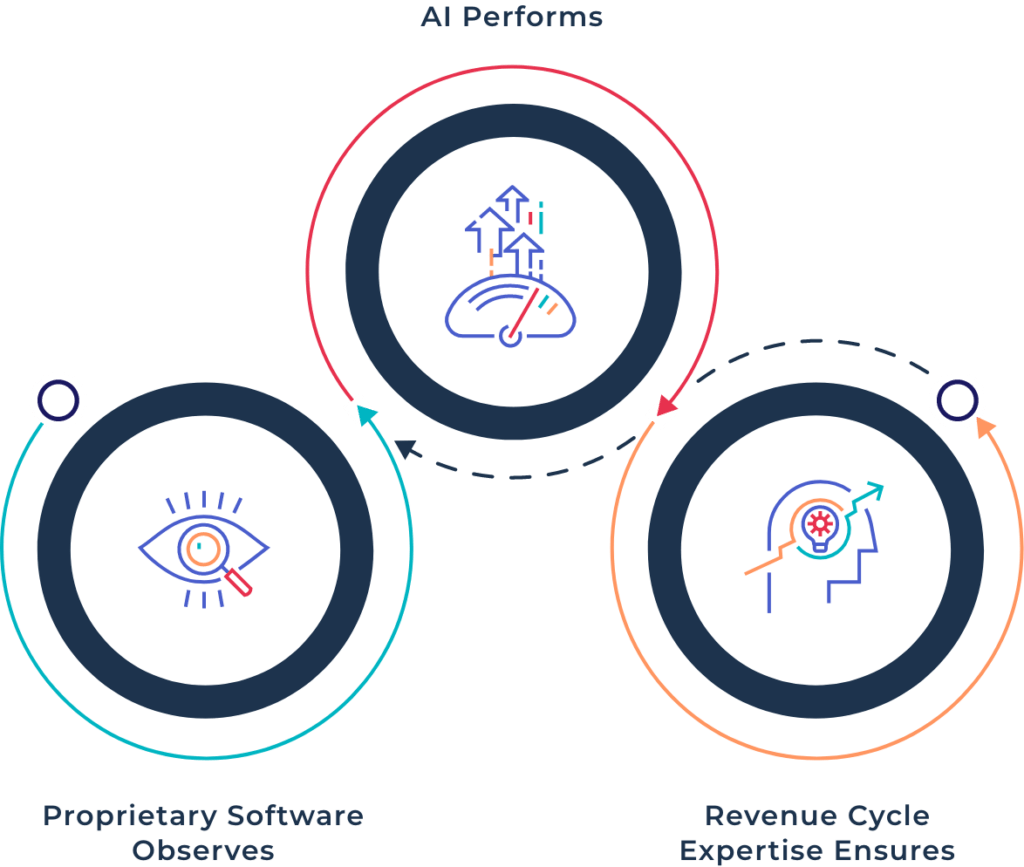The Gist
The cloud provides flexible computing that’s changed how many businesses meet their technology needs for the past decade. It’s little wonder, as the cloud is truly scaleable, more affordable than going in-house, and requires little overhead. Now, it’s time cloud technology revolutionize healthcare in the same way it’s changed so many other industries. And AKASA is at the forefront.
The following post first appeared August 20, 2020 on the AWS Startups Blog
Businesses of all sizes and from every industry have come to understand the benefits of embracing a cloud approach to computing, from immediate access to massive computing power to IT infrastructure costs that scale in alignment with business activity.
While many may assume that the benefits of the cloud may stop with the IT department, solutions that build on the cloud can extend these same benefits to other areas of operations. In fact, our company, AKASA, is doing just that in healthcare revenue cycle management (RCM).
The Current Problems with American Healthcare
Healthcare reform has been a hot-button political issue for decades, and for good reason. Healthcare in America is deeply complex, and as a result, highly expensive.
The U.S. spent about $3.6 trillion on healthcare in 2018 according to the Centers for Medicare and Medicaid Services. Recent studies have found that fully one-quarter of healthcare spending in the U.S. is wasteful. Administrative costs, which include medical billing and claims processing, contribute the most significant share of that wasteful spending. A recent JAMA study estimated that this administrative complexity accounts for $266 billion in wasted spending annually.
Henry Ford once said, “Don’t find fault, find a remedy. Anybody can complain.” Financial complexity in healthcare with countless codes and complicated steps for billing and reimbursement is easy to complain about. “Fixing” the complexity in our healthcare system will likely require massive national healthcare policy reform and take decades to achieve. We simply can’t afford to wait.
At AKASA, we believe every dollar spent on healthcare matters and our mission is to remedy the financial complexity that is crippling healthcare in the U.S.

Cloud Computing, Unified Automation, and Healthcare
Our team developed new approaches and built technology from the ground up that is purpose-built to automate revenue cycle operations for healthcare. We call our solution Unified Automation. It combines traditional robotic process automation (RPA), with leading-edge AI, machine learning (ML), and human experts-in-the-loop.
When creating our automation platform, we not only had to think about the goals of our automation, but also the foundation. What kind of security and servers would we want? Eventually, we landed on Amazon Web Services (AWS), and for a number of reasons.
Security
Being in the healthcare operations space, security is of utmost importance. We needed to build our automation on a secure platform where we could value the security of our customer’s data as if it were our own.
AWS’ HiTrust and HIPAA-compliant cloud provides healthcare organizations with immediate peace of mind. Building our solution on AWS bakes this high degree of security and compliance into our solution as well.
Big financial wins
A major reason cloud computing saw rapid, widespread adoption is because it minimizes an organization’s need to invest in physical hardware and other fixed costs. Access to on-demand computing power and capacity through the cloud allows these expenses to scale directly with operations. Likewise, AKASA can help health systems minimize the need to invest in a cumbersome patchwork of different technologies and services that may still require armies of staff or consultants to use.
Additionally, using cloud-based automation to better align costs to revenue creates better financial health for healthcare. Many health systems operate with massive fixed or pseudo-fixed costs, this often creates an incentive to maximize procedures or laboratory tests with higher margins that provide the revenues to offset these fixed costs. When this dynamic overshadows simply doing whatever is best for patients, the quality of care can suffer.
Health systems that proactively look for ways to restructure costs and keep them aligned with operational expenses ultimately protect their organization’s ability to put patients first while also protecting their bottomline. Finally, AKASA also uses a shared-value model so the more work health systems automate, the more they save. Financially, everybody wins.
Building Flexibility
Before cloud computing, computers, servers and other hardware often sat idle until it was needed to support a spike in demand for computing power or capacity. When work volumes normalized, those resources would sit idle until the next spike in activity occurred. Shifting to the cloud eliminates the need to invest in “stand by” resources since additional computing power and capacity is available “on demand” through the cloud.
Similarly, revenue cycle leaders without a good cloud-based automation partner may find that spikes in demand lead to the expensive and demoralizing cycle of going through layoffs one month only to be faced with trying to hire and train new employees as quickly as possible just a few months down the line. Revenue cycle operations are traditionally highly manual and work intensive, meaning health systems usually have hundreds if not thousands of employees working in revenue cycle operations so the business ramifications of volatility in demand can not be overstated.
In a survey of more than 5,000 adults across the U.S. commissioned by AKASA and conducted by SurveyMonkey, more than 60 percent of Americans said they would wait at least one to six months after shelter-in-place orders have been listed to return to routine healthcare. More than 40 percent of survey respondents said that concerns of contracting COVID-19 in a healthcare setting was actively preventing them from seeking care.
With case counts climbing across the country and many states facing extended or secondary shelter-in-place orders, it’s clear that health systems are facing a long period of market uncertainty and volatility due to COVID-19.

Fully automating core revenue cycle tasks such as prior authorization and claim status provides on-demand access to capacity and maintains productivity for key RCM activities. Automating these core functions allow RCM leaders to have staff focus on work that returns the greatest value to the organization while automation scales up and down in real-time with business needs.
In early March, we saw a 56 percent increase in demand at one of our health system customers. Our Unified Automation solution adjusted seamlessly, picking up the additional work volume. The additional output was equivalent to adding five full-time, highly productive team members in a single week with no advance notice.
Automation scales up and down effortlessly with no burden on revenue cycle leaders to make those adjustments. This affords revenue cycle leaders with greater flexibility to adjust to volatile work volumes while also providing their team with some measure of insulation against volatility-driven layoffs.
Building Resilience
Natural disasters have historically been just as disastrous for businesses as they were for nature. If your organization’s hardware and servers were damaged in an earthquake or hurricane, the data and information stored on those assets were often permanently destroyed. Companies moved to establishing secondary server locations and/or co-locating in a server farm to mitigate this risk. Moving to the cloud has protected some IT operations against these kinds of external shocks all together.
Likewise, the only way for revenue cycle teams to create an operational failsafe in today’s environment is to have workers who live in the cloud. Cloud based automation of full revenue cycle tasks act as virtual staff. AKASA’s Unified Automation operates from within a health system’s existing EMR and billing systems, leaving audit trails of every action it takes.
However, because the automation is cloud based it can continue working regardless of whatever external shocks a health system may face – be they earthquakes, hurricanes or global pandemics. Virtual workers are completely unaffected by environmental factors and can continue performing consistently 24/7.

One of our health system clients told us in March, 2020 that AKASA served as just such an operational failsafe when their entire revenue cycle team made the abrupt and unplanned transition to remote work due to COVID-19 shelter-in-place orders. An extrapolation based on our data indicated that the customer’s staff output in the work queues that we automate fell by an estimated 40 percent in the last week of March, while AKASA’s Unified Automation output was consistent across the same period of time. In that last week of March, our Unified Automation system performed work equivalent to 14 full-time and highly productive staff members.
Working Smarter, Not Harder
The combination of AWS’ S3, Application Load Balancer and Cognito features are critical foundational elements for running the proprietary software we’ve developed that captures multi-modal data of workflows at our health system customers to provide a 360 degree view of current revenue cycle processes. We use this data to train our automation, but we also return insights back to our customers that show how their team spends most of their time in the course of daily work. These insights are essential for helping teams work smarter not harder and AWS offers the best combination of features to ensure we work smarter rather than harder in our own efforts to capture these insights.
Automating a Better Future for Healthcare
Automation systems built on the cloud offer numerous business benefits to health systems. Perhaps most exciting, is that we are in the very early days in the technological development of these kinds of solutions that are purpose built for healthcare. AKASA’s unique approach to automation for healthcare revenue cycle management unifies proprietary machine-learning technologies with human judgment and deep expertise in revenue cycle management. Our solution brings together the best of people, data and technology to efficiently, accurately and autonomously navigate the complex state of medical reimbursement in the U.S. And we couldn’t possibly have built it without a cloud partner like AWS.
Schedule a free demo and see for yourself how AKASA’s Unified Automation can help you streamline your revenue cycle and do more with less.

Varun Ganapathi, Ph.D., is the chief technology officer and co-founder of AKASA. His passion is developing novel algorithms to power great products, with a focus on healthcare and improving the patient experience. Ganapathi has a bachelor’s in physics and an M.S. and Ph.D. in computer science from Stanford University. During his time at Stanford, he focused on machine learning and computer vision. His doctoral thesis was the basis of his first company, Numovis, which was acquired by Google. After his time at Google as a research scientist, Ganapathi went on to create Terminal.com, which was acquired by Udacity.










